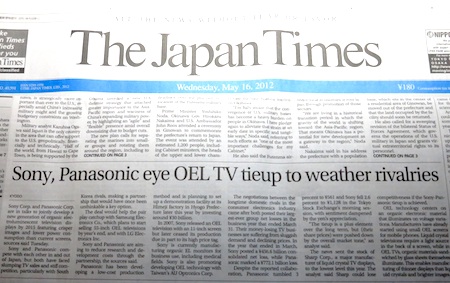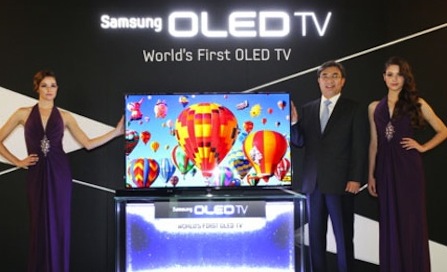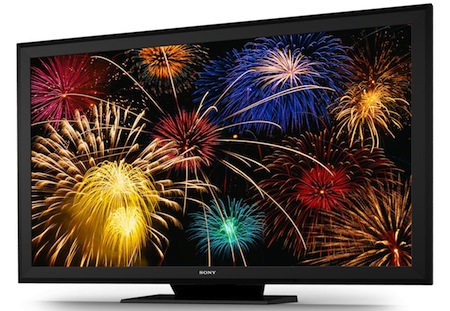UPDATE: Panasonic and Sony confirm plans to join forces for OLED TV development
Two of Japan's biggest TV rivals confirm they are to pool resources in an OEL TV joint venture to face threat from Korean competition

Update 25.05.12
Sony and Panasonic have today confirmed they are to combine forces to develop large-screen OEL/OLED TV panels.
As we reported a month ago, the two Japanese companies, each of which is struggling to turn round its ailing TV division and reverse losses, decided to join up to tackle the threat from Korean rivals Samsung and LG.
The two Korean companies plan to launch OLED TVs this year, and currently lead the Japanese TV industry by a considerable margin in global TV sales.
The Panasonic/Sony alliance aims to establish technology by next year to produce the OEL panels, which are capable of higher image quality while using less energy.
The two companies have so far been working on different approaches to manufacture of the panels, Sony with a system based around spraying materials as a high-temperature vapour, Panasonic basing its technology on ink-jet printing.
Reports in Japan suggest the two may look to Taiwan for the manufacture of panels produced under the alliance: Panasonic is thought to be looking at a variety of lower-cost locations for panel manufacture, while Sony already has a tie-up for OEL TV technology with Taiwan's AU Optronics.
Get the What Hi-Fi? Newsletter
The latest hi-fi, home cinema and tech news, reviews, buying advice and deals, direct to your inbox.
It's thought Panasonic will work with Sony to seek co-operation with AU Optronics.
Posted 16.05.12
Panasonic and Sony, long-term rivals in the global TV market, look set to put aside their historic differences and co-operate on the development of 'a new generation' of TVs using organic electroluminescent displays – otherwise known as OEL or OLED.
Reported by the press here in Japan today, the 'we didn't see that one coming' move shows the two are either determined to see off the threat from Korean rivals LG and Samsung, or struggling to play catch-up with the those two companies, which currently lead the worldwide TV market.

Quoting sources close to the negotiations between the two, The Japan Times says that 'Sony and Panasonic compete have faced slumping TV sales and stiff competition, particularly from South Korean rivals, making a partnership that would have once been unthinkable a key option.'

News of the joint venture comes just less than a week after global TV leader Samsung attempted to steal a march on LG by announcing availability and pricing for its 55in OLED (above) – it'll hit the shops in Korea later this year, and sell for just under $10,000, making it twice the price of the company's current flagship TV.
And it's clear that both Panasonic and Sony need to produce something to turn around their consistently loss-making TV operations, and do so as economically as possible.
Both companies posted losses for the financial year recently ended – Sony Y456.6 (just over £3.5bn) in the red, and Panasonic Y772.1 (around £6bn) – and both cited the continued woes of their TV divisions as a major contributing to the poor performance.
But the Japanese stock market had a cool response to the news of the joint venture: Panasonic shares fell 3% and Sony's 2.6% due to the growing value of the Yen, with the joint venture doing nothing to halt the slide.
But the announcement did, however, have positive effect for the two: rival Sharp saw its share price fall to the lowest level this year, in part due to the greater threat the joint venture could present.
Sony is no stranger to OEL technology: it launched an 11in TV using the technology five years ago, but halted production due to slow uptake and high prices, and manufactures OEL displays for medical, professional and industrial use.

It's also been talking about developing the technology with Taiwanese company AU Optronics, but surprised the world's press at the CES show in January by showing not an OEL TV but one using its Crystal LED technology (above), using millions of micro-LEDs to form the image rather than OEL's electro-reactive organic material.
Where this announcement leaves Crystal LED isn't clear, although at the time it showed the TV prototype Sony did say its OEL development would continue in parallel.
Panasonic, meanwhile, has said it's investing Y30bn, or around £250m, in a demonstration OEL production line at its Himeji factory in Japan, originally built as the company's latest hub for the manufacture of LCD TV displays.
By contrast, Samsung last week announced a £2.6bn investment in its OLED TV business.
It's expected 2.1m OLED TVs will be sold in 2015, which is when the Panasonic/Sony joint venture is said to be aiming to have product on sale. Around 34,000 sets are predicted to be sold this year.
Andrew has written about audio and video products for the past 20+ years, and been a consumer journalist for more than 30 years, starting his career on camera magazines. Andrew has contributed to titles including What Hi-Fi?, Gramophone, Jazzwise and Hi-Fi Critic, Hi-Fi News & Record Review and Hi-Fi Choice. I’ve also written for a number of non-specialist and overseas magazines.
